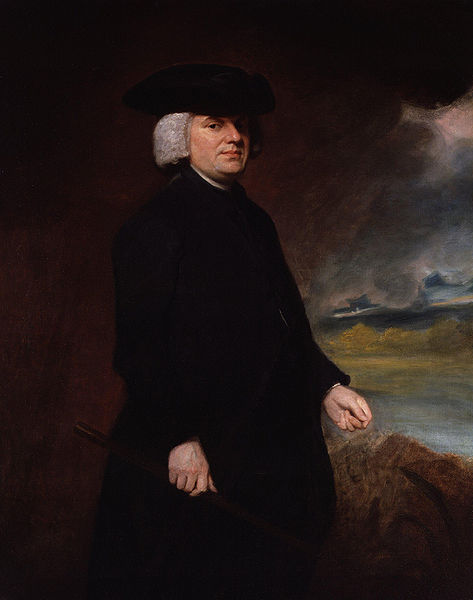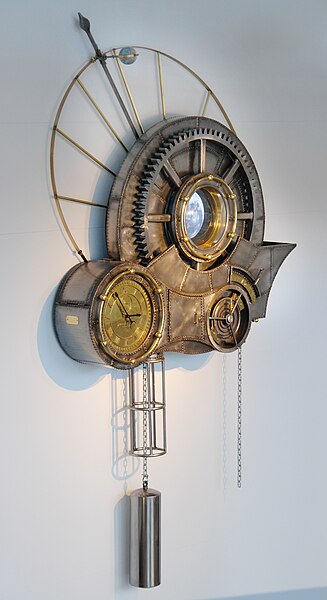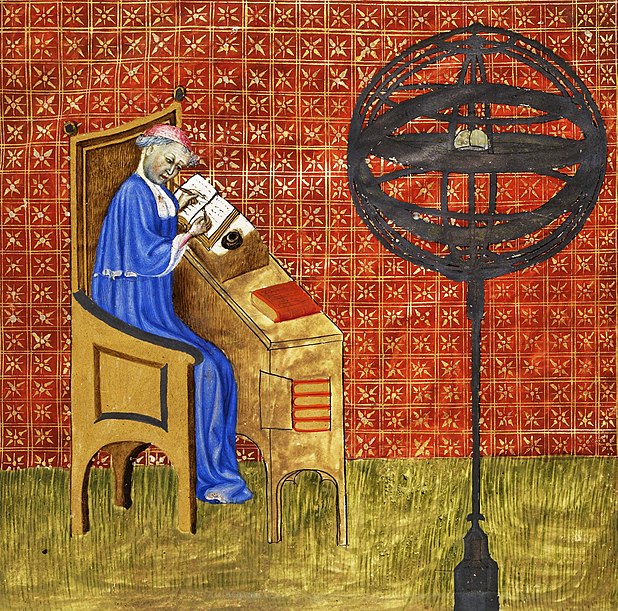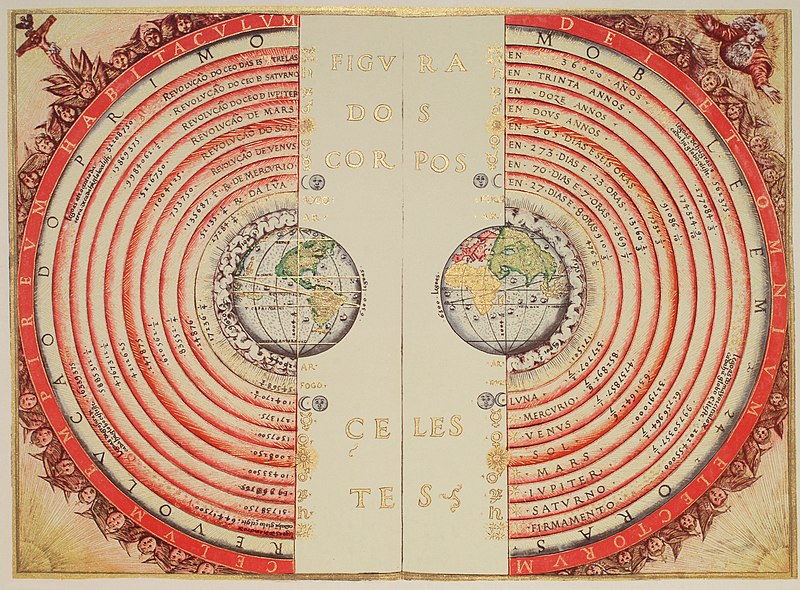

 |
 |

Tim Wetherell's Clockwork Universe sculpture at Questacon, Canberra, Australia (2009). Image courtesy of Wikipedia.
The clockwork universe is popularly associated with Sir Isaac Newton (1642-1727), but it turns out that both he and his close philosophical supporter Samuel Clarke both strongly criticized the notion of the clockwork universe, because it left no room for Divine Providence.
Before I address Feser's criticisms, I'd like to make a few remarks about the historical background of the watch metaphor attributed to Paley, and the closely related idea of the clockwork universe, which many people falsely imagine to have originated with Isaac Newton. In fact, Newton was strongly opposed to the clockwork universe theory: he believed that it was theologically inappropriate, because it ignored God's providential role in sustaining the universe. This sentiment of Newton's was reflected in the writings of Newton-supporter Samuel Clarke. Responding to Gottfried Leibniz, a prominent supporter of the theory, in the Leibniz–Clarke correspondence, Clarke wrote:
"The Notion of the World's being a great Machine, going on without the Interposition of God, as a Clock continues to go without the Assistance of a Clockmaker; is the Notion of Materialism and Fate, and tends, (under pretence of making God a Supra-mundane Intelligence,) to exclude Providence and God's Government in reality out of the World."
(See Davis, Edward B. 1991. "Newton's rejection of the 'Newtonian world view': the role of divine will in Newton's natural philosophy." Science and Christian Belief 3, no. 2: 103-117. Abstract here.)
As for Newton himself, Professor Edward Davis has this to say, in the abstract of the above-mentioned article:
...[T]he typical picture of Newton as a paragon of Enlightenment deism, endorsing the idea of a remote divine clockmaker and the separation of science from religion, is badly mistaken. In fact Newton rejected both the clockwork metaphor itself and the cold mechanical universe upon which it is based. His conception of the world reflects rather a deep commitment to the constant activity of the divine will, unencumbered by the "rational" restrictions that Descartes and Leibniz placed on God, the very sorts of restrictions that later appealed to the deists of the 18th century.Newton's voluntarist conception of God had three major consequences for his natural philosophy. First, it led him to reject Descartes' version of the mechanical philosophy, in which matter was logically equated with extension, in favor of the belief that the properties of matter were freely determined by an omnipresent God, who remained free to move the particles of matter according to God's will. Second, Newton's voluntarism moved him to affirm an intimate relationship between the creator and the creation; his God was acted on the world at all times and in ways that Leibniz and other mechanical philosophers could not conceive of, such as causing parts of matter to attract one another at a distance. Finally, Newton held that, since the world is a product of divine freedom rather than necessity, the laws of nature must be inferred from the phenomena of nature, not deduced from metaphysical axioms -- as both Descartes and Leibniz were wont to do.
The Catholic philosopher and Intelligent Design advocate Jay Richards discusses Newton's theological views in his book, God and Evolution (Discovery Institute, Seattle, 2010). In chapter 12, in an essay entitled, "Separating the wheat from the chaff", he writes:
Newton ... once wrote: "[W]here natural causes are at hand God uses them as instruments in his works, but I do not think them sufficient alone for ye Creation."For Newton, God maintained and interacted with everything in the physical universe, which he called the "divine sensorium." (2010, p. 233)
 |
 |
Left: Portrait of Nicole Oresme: Miniature from Oresme's Traite de l'espere, Bibliotheque Nationale, Paris, France, fonds francais 565, fol. 1r. Image courtesy of Wikipedia.
Right: The astronomical clock on the Old Town Hall in Prague. Image courtesy of Maros Mraz and Wikipedia.
Where did the clockwork universe theory originate, then, if not with Newton? Readers might be surprised to learn that the notion of the clockwork universe is not a product of the mechanistic science of the 17th century, as is popularly assumed. In fact, it was commonly used in the Middle Ages, and certainly goes back at least as far as the 14th century.
Astrophysicist Adam Frank, who is the author of a recent best-seller entitled, About Time: From Sun Dials to Quantum Clocks, How the Cosmos Shapes Our Lives (Oneworld Publications, Oxford, 2012), contends that mechanical clocks, which became widespread in Europe in the 14th century, radically changed the way we view the cosmos itself, as the metaphor of the "clockwork universe" began to take hold. An excellent review of Frank's book, by science journalist Dan Falk, can be found here.
Frank quotes from the writings of the medieval philosopher, mathematician and scientist, Bishop Nicole d'Oresme (1330-1382), who described the world as "a regular clockwork that was neither fast nor slow, never stopped, and worked in summer and winter." As for the planets circling above, Oresme found them "similar to when a person has made a horologe [a clock] and sets it in motion, and then it moves by itself."
Oresme played a very important role in popularizing the clockwork universe metaphor. However, the roots of the metaphor can be traced back to the 13th century and beyond. As we shall see, the metaphor of the universe as a machine is a very ancient one.

Figure of the heavenly bodies - an illuminated illustration of the Ptolemaic geocentric conception of the Universe by Portuguese cosmographer and cartographer Bartolomeu Velho (d. 1568). Bibliotheque Nationale, Paris.
John of Sacrobosco's popular medieval astronomy text, On the Sphere of the World (c. 1230), popularized Ptolemy's geocentric model. In his book, Sacrobosco talked about what he called the machine of the world, made in the likeness of an Archetype in the Mind of God. The clockwork universe was alive and well, even in the 13th century. Image courtesy of Wikipedia.
The concept of the clockwork universe is invoked in John of Sacrobosco's early 13th-century introduction to astronomy, On the Sphere of the World (c. 1230), which was widely popular in the Middle Ages. Indeed, it was one of the most influential works of pre-Copernican astronomy in Europe, as it was required reading for students at all Western European universities for the next four centuries after it was published. St. Thomas Aquinas (1225-1274) would certainly have read it, too.
In his book, Sacrobosco spoke of the universe as the machina mundi, or machine of the world. Sacrobosco regarded the universe as having been made in the likeness of an Archetype, or Idea in the Mind of God, Who disposed it to behave in a regular fashion. At the end of his book, Sacrobosco also suggested that the reported eclipse of the Sun at the crucifixion of Jesus Christ was a disturbance in the order of the machine of the world. Hence it could only have been a miracle.
In the last few centuries, the notion of the clockwork universe has been used to minimize the role of God, but that was not how it was originally understood in the 13th century. The following extracts from Sacrobosco's book illustrate the supernaturalism which pervades his work:
CHAPTER ONETHE FOUR ELEMENTS. The machine of the universe is divided into two, the ethereal and the elementary region. The elementary region, existing subject to continual alteration, is divided into four For there is earth, placed, as it were, as the center in the middle of all, about which is water, about water air, about air fire, which is pure and not turbid there and reaches to the sphere of the moon, as Aristotle says in his book of Meteorology. For so God, the glorious and sublime, disposed....
THE HEAVENS SPHERICAL. There are three reasons why the sky is round: likeness, convenience, and necessity. Likeness, because the sensible world is made in the likeness of the archetype, in which there is neither end nor beginning; wherefore, in likeness to it the sensible world has a round shape, in which beginning or end cannot be distinguished. Convenience, because of all isoperimetric bodies the sphere is the largest and of all shapes the round is most capacious. Since largest and round, therefore the most capacious. Wherefore, since the world is all-containing, this shape was useful and convenient for it. Necessity, because if the world were of other form than round -- say, trilateral, quadrilateral, or many-sided -- it would follow that some space would be vacant and some body without a place, both of which are false, as is clear in the case of angles projecting and revolved....
CHAPTER TWO - OF THE CIRCLES AND THEIR NAMES
THE TWO MOVEMENTS AGAIN. Be it understood that the "first movement" means the movement of the primum mobile, that is, of the ninth sphere or last heaven, which movement is from east through west back to east again, which also is called "rational motion" from resemblance to the rational motion in the microcosm, that is, in man, when thought goes from the Creator through creatures to the Creator and there rests.
The second movement is of the firmament and planets contrary to this, from west through east back to west again, which movement is called "irrational" or "sensual" from resemblance to the movement of the microcosm from things corruptible to the Creator and back again to things corruptible....
CHAPTER FOUR
ECLIPSE DURING THE PASSION MIRACULOUS. From the aforesaid it is also evident that, when the sun was eclipsed during the Passion and the same Passion occurred at full moon, that eclipse was not natural -- nay, it was miraculous and contrary to nature, since a solar eclipse ought to occur at new moon or thereabouts. On which account Dionysius the Areopagite is reported to have said during the same Passion, "Either the God of nature suffers, or the mechanism of the universe is dissolved."

Image of St. Thomas Aquinas (1225-1274) depicted in stained glass. Courtesy of Wikipedia.
Aquinas argued that just as a clock is directed to its time-keeping function by the clockmaker, so too every natural object in the world is directed to its (built-in) goal by its Maker, God.
I should also like to point out that St. Thomas Aquinas, who lived during the thirteenth century, used the clock analogy, in his theological writings. In his own words:
...[T]he order of the reason of the mover appears in all things which are moved by reason, granted the thing itself which is moved by reason may not have reason; for thus does the arrow tend directly to the target from the motion of the archer, as if it itself had the reason of the one directing it. And the same appears in the motion of clocks, and of all works of human ingenuity, which come to be by art. However, just as artifacts are compared to human art, so also all natural things are compared to divine art. (Summa Theologica, I-II, q.13, art.2, ad. 3.)
We can now see how misleading is the statement in Professor Christopher Martin's Thomas Aquinas: God and Explanations, in his chapter, The Fifth Way, that "according to the great computerised Index Thomisticus, in the 8,000,000 words Thomas Aquinas definitely wrote, and the 3,000,000 he may have written besides, the universe is never compared to a clock."...
It is true that Aquinas does not explicitly liken the world to a clock, in the passage above. (As we'll see below, neither does Paley - although in Chapter XXIII of his Natural Theology, he does use the illustration of a watch to argue that the world could only be ordered and kept in motion by a Designer Who is still living, just as a watch in motion shows the existence of an original designer and of a force keeping it moving.) What Aquinas seems to be saying, though, is that just as an arrow is directed to its target by an archer, and a clock is directed to its time-keeping function by the clockmaker, so too every natural object in the world is directed to its (built-in) goal by its Maker, God.
Professor Feser might point out in reply that while Aquinas does make use of the clock analogy in the above passage, he does not invoke it in his famous Five Ways, or arguments for the existence of God. That's true; but the analogy of the arrow is used by Aquinas, in his famous Fifth Way. If the latter analogy is inappropriate in an argument for the existence of God, then surely, so is the former.
There's more. There are a couple of passages in Aquinas's writings where he talks about the machine of the world (machina mundi). Had Professor Christopher Martin typed the word "machina" into the search engine at Corpus Thomisticum, his search would have been a more fruitful one.
The first and most striking passage is in Aquinas' Compendium of Theology, Book 1, chapter 170, which is available online in both Latin and English. In this chapter, Aquinas discusses the question of what will remain in the New Heaven and the New Earth. He says there won't be any plants and animals, as they are essentially corruptible and mortal, and man will no longer have any need for them. However, Aquinas thinks that the heavenly bodies (which he viewed as incorruptible) and the elements will still remain. In the final paragraph, he explains why:
...the essential parts of the universe are the heavenly bodies and the elements, for the entire world machine is made up of them.
The second passage is available online only in Latin. In his Quodlibet XI, question 1, Aquinas discusses the question of whether it belongs to God alone to be everywhere (circa immensitatem vero Dei quaesitum fuit utrum solius Dei sit proprium esse ubique).
One objection Aquinas considers in his sixth argument is that because the entire "machine of the world" is one continuous body - Aquinas, following Aristotle, didn't believe in the possibility of a vacuum - which can be found everywhere, it follows that the property of being everywhere (ubiquity) is not unique to God, after all.
Praeterea, dato quod tota machina mundialis esset unum corpus continuum, constat quod illud corpus esset ubique. Non ergo est solius Dei proprium esse ubique.
In his reply to the objection, Aquinas distinguishes between different senses of being in a place: God alone is present, whole and entire, everywhere, and contains any place where He is said to be present, whereas a body (such as the machine of the world, which can be treated as one continuous body) is contained within the place where it is said to be:
Ad sextum dicendum, quod dato quod tota machina mundialis esset unum corpus continuum, non tamen propter hoc posset imaginari quod esset ubique, sed in uno loco tantum: quia totum illud in quo esset, acciperetur pro uno loco; et sic non attingeret quodlibet particulare, quod esse ubique complectitur in sua ratione.
We have seen that Aquinas, writing in the thirteenth century, invoked the analogy of a clock being directed to its time-keeping function by a clockmaker, in order to explain how every natural object in the world is directed to its (built-in) goal by its Maker, God. We have also seen that he referred to the "machine of the world" in his theological writings. I conclude that Aquinas would not have been alarmed at the metaphor of the clockwork universe, which was first made fully explicit by Bishop Oresme (1330-1382) in the fourteenth century.
 |
 |
Left: Cicero (106 - 43 B.C.) at the age of about 60, from a marble bust. Image courtesy of Wikipedia.
Cicero argued that if we can be sure that a water-clock can only be produced by some intelligent being, then we can be even more certain that the universe, whose movements are much more precise and intricate than any clock's, is directed by a Higher Intelligence.
Right: An ancient water-clock. The image above is a 19th century illustration of Ctesibius's clepsydra from the 3rd century BC. In this example, water enters and raises the human figure, which points at the current hour for the day. Spillover water operates a series of gears that rotates a cylinder so that the hour lengths are appropriate for today's date. Source: Abraham Rees (1819) "Clepsydra " in Cyclopaedia: or, a New Universal Dictionary of Arts and Sciences. Image courtesy of Wikipedia.
However, the notion of the clockwork universe is not of medieval origin; it actually goes back to antiquity. Its most famous exponent in ancient times was Marcus Tullius Cicero (106-43 B.C.), who carefully developed the analogy in Book II of his work, The Nature of the Gods:
How is it consistent with common-sense that when you view an image or a picture, you imagine it is wrought by art; when you behold afar off a ship under sail, you judge it is steered by reason and art; when you see a dial or water-clock, you believe the hours are shown by art, and not by chance; and yet that you should imagine that the universe, which contains all arts and the artificers, can be void of reason and understanding? (Book II, Section XXXIV)Is he worthy to be called a man who attributes to chance, not to an intelligent cause, the constant motion of the heavens, the regular courses of the stars, the agreeable proportion and connection of all things, conducted with so much reason that our intellect itself is unable to estimate it rightly? When we see machines move artificially, as a sphere, a clock, or the like, do we doubt whether they are the productions of reason? And when we behold the heavens moving with a prodigious celerity, and causing an annual succession of the different seasons of the year, which vivify and preserve all things, can we doubt that this world is directed, I will not say only by reason, but by reason most excellent and divine? (Book II, Section XXXVIII)
Here, Cicero used the clock analogy, not in order to argue that the universe is a giant clock, but rather to argue that if we can be sure that a clock can only be produced by some intelligent being, then we can be even more certain that the universe, whose movements are much more precise and intricate than any clock's, is directed by a Higher Intelligence.